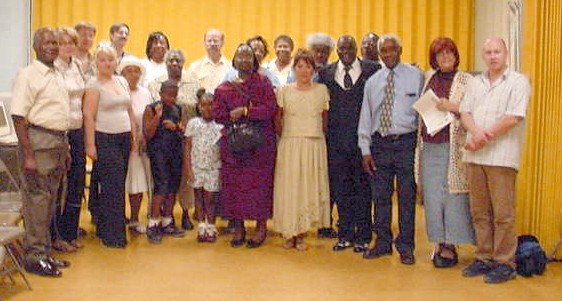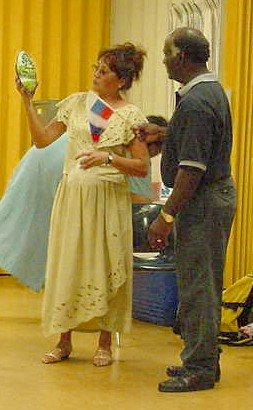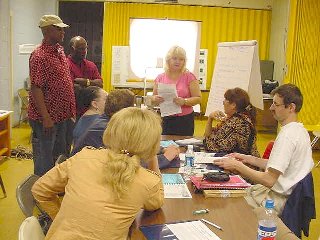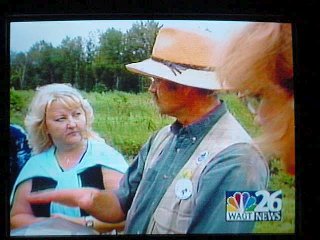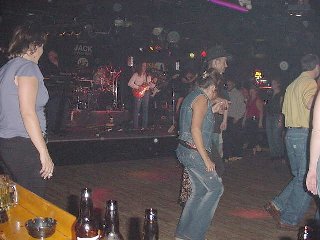|
Date
of Project: September 4 — 11, 2004
Summary of Project Accomplishments Blue Ridge Environmental Defense League’s received support from the ISAR Open World Program in September 2004 for our project entitled: “Environmental Pollution at Savannah River Weapons Site.” Our project had the following objectives: to tour the SRS weapons facility, to enlist support of local colleges and universities, to conduct trainings and testing events for air contaminants, to hold press events to publicize US and Russian activists’ concerns, to organize varied community meetings throughout the central Savannah River area, and to attend a meeting of the national Alliance for Nuclear Accountability. SRS was chosen for this project because it has 51% of the United State’s weapons-related high-level radioactive waste: 490 million Curies. BREDL’s purpose is to ensure a complete clean up at SRS and to prevent new contamination. The overall goal of the project was to bring together Russian and American activists working on common problems to build collaborative efforts with mutual benefits. In this we were successful beyond our expectations. From September 5th to 10th, our program of work achieved the following: meetings with the Mayor and elected officials of Augusta, three local community meetings, four professional meetings, an air pollution testing expedition, five cultural events, and two press conferences resulting in three days of media coverage. Innovative scientific methods for detecting environmental pollutants were shared. The personal contacts made during this project will further international cooperation, both at the academic and grassroots levels, for years to come. Description of Project Activities The ISAR delegates’ week in Augusta, Georgia was comprised of professional meetings, social gatherings and cultural events. Professional Meetings The ISAR delegates attended the day long Fall Meeting of the Alliance for Nuclear Accountability (ANA) which was held in the state capital of Columbia, South Carolina. The ANA is a national coalition of activists living near atomic weapons sites (See website at http://www.ananuclear.org). The Russians’ participation in ANA’s Fall Meeting provided a forum for the exchange of views on the technical issues and the social impacts of radioactive sites in both nations. ISAR delegates attended a series of plenary sessions and small group discussions on environmental policy and public health issues including waste clean-up, weapons testing, new production, stockpile maintenance, nuclear proliferation, and a panel of citizens with expertise in the Savannah River nuclear weapons site. The highlight of the day was a panel entitled, “Open World International Exchange Program” during which four ISAR delegates addressed the assembly. During the week a series of events were held at historic Paine College in Augusta, Georgia. Dr. C. R. Nair, Associate Professor in the Department of Chemistry, Physics and Environmental Sciences, met with the delegates to explore recent research in radionuclide and toxic pollutant testing in Russia, resulting in an ongoing collaborative effort to publish the testing methods and results in the US. The delegates also met with students and their professor to discuss environmental and public health issues in Russia. After the initial presentation by delegates, an open question and answer period followed. Issues included local issues and how they relate to broader international experience in environmental policy. Finally, Paine College President Dr. Shirley Lewis met with the delegates and welcomed them to the historic college. Photographs of the meeting will be published in an upcoming publication. Meetings with Public Officials ISAR delegates had a private meeting with the City of Augusta’s Mayor, Bob Young, to discuss environmental policy. During the meeting at his office in City Hall, the Mayor discussed the details of Augusta’s program to reclaim land which was contaminated with industrial pollution. These sites, called brownfields, are made usable again for community activities and commercial development. This program was of great interest to ISAR delegates seeking advice on practicable programs to restore damaged sites and protect public health. BREDL’s Charles Utley secured a place on the agenda of the Augusta City Commission, the elected leaders of Augusta’s municipal government, for ISAR Russian delegates. Milya Kabirova and Dmitry Rybakov introduced ISAR’s Resources for Environmental Activists program to the Commissioners and raised environmental issues common to both the United States and Russia regarding former nuclear weapons sites. BREDL distributed a press release with statements from four ISAR delegates who also interviewed with local news media. These events resulted in three days of news coverage. Air Pollution Testing Expedition and Savannah River Site Tour Although the Savannah River Office of the US Department of Energy prohibited ISAR delegates from taking the scheduled official tour of the Savannah River Site, BREDL took ISAR delegates on an unofficial tour through the site on roads accessible to the public. Our tour was also a field trip which included training sessions and a sample gathering expedition. Louis Zeller, Research Director for the Blue Ridge Environmental Defense League, led a field workshop on the science and practice of air pollution testing. Delegates learned how to take grab-samples of air for laboratory testing. Two local network television crews accompanied the expedition, resulting in TV news coverage. Cultural Activities ISAR delegates visited the Savannah Riverwalk and strolled along the top of the 19th century levee. The Riverwalk is the centerpiece of Augusta’s downtown area and features many historical markers, art sculptures and educational displays. ISAR delegates attended the 10th Annual Augusta Jazz Festival which is held at the Jesse Norman Amphitheater overlooking the Savannah River. A highlight of the evening’s entertainment was vocalist and recording artist Jennifer Holliday. Delegates went on two major shopping trips: the huge Augusta Mall which has many department stores and shops and the Wal-Mart, an American commercial icon. BREDL took delegates on the Augusta Canal Boat Tour, a guided trip in open Petersburg riverboats. The Augusta Canal is an 8 mile waterway built in 1845 to harness the power of the Savannah River for local industry and commerce. The tour guide pointed out many historical and natural points of interest. On the final night of the project, Lou Zeller took delegates to Coyote’s Dance Hall, a southern “honky tonk” with billiard tables, a bar, a dance floor and a live band. Line dancing, the “slide” country dancing, and 8-ball were part of the evening’s entertainment. Social Events On Sunday morning ISAR delegates attended McElmurray Spring Branch Baptist Church, a small country church near Waynesboro, Georgia. Rev. Charles Utley and the church congregation gave the delegates a warm welcome. On Sunday evening delegates attended a reception given by the Hyde and Aragon Park Neighborhood Association. President Charles Utley, a lifelong resident of Augusta and a community leader in many local environmental justice issues, hosted the meeting at the Community Center. About two dozen members of the local community attended and heard each delegate make a short presentation with the help of our interpreter. On Labor Day, BREDL and the Hyde and Aragon Park Neighborhood Association held a day-long meeting allowed delegates and hosts to get acquainted and to discuss the activities for the week including a press release, the mayor‘s meeting, SRS tour, and academic contacts. Delegates listened to community leaders’ presentations on local environmental issues. Lou Zeller also organized a goal-setting session for the ISAR delegates to determine their priorities for the upcoming week’s agenda. Later, Arthur Smith invited delegates to his home view a video on environmental justice issues in Augusta which tells the story of how local residents forced the City of Augusta to clean up contaminated industrial sites poisoning the residential communities of Hyde Park, Aragon Park, and Virginia Subdivision. The Importance of These Activities The activities were designed to accomplish as much as possible within one week. Most events combined social contacts with educational and cultural purposes. In this way, we made the most of time and resources. A few examples follow. At the Alliance for Nuclear Accountability meeting, Milya Kabirova, Larisa Korneva, Konstantin Kozlov and Dmitry Rybakov made formal presentations and were very well received by the assembly. What had been scheduled for 30 minutes was extended by popular demand to over an hour of discussion and questions and answers. Ongoing collaborations will be built upon the contacts made at this meeting. The meeting with Arthur Smith at his home in Aragon Park was ostensibly a social gathering with hospitality provided by the Smiths, but the viewing of a locally produced video provided great opportunity for delegates to become familiar with a successful and ongoing grassroots advocacy campaign. The Augusta brownfield project was spearheaded by the Hyde and Aragon Park Neighborhood Association. This precedent-setting grassroots effort is the sole example of a community group writing and receiving approval for a federal brownfields project. ISAR delegates were most interested in this project because it provides a model for how they might could gain assistance in cleaning up contaminated sites in Chalyabinsk and other locations. Copies of the brownfield consultant’s report were provided to all the delegates at their request. During the training on air pollution sampling, we took grab samples at two locations outside the Savannah River Site based on that day’s wind patterns. The samples were shipped to a certified laboratory to detect levels of atmospheric pollution. The 310 square mile SRS site contains many closed reactors, manufacturing plants, and waste sites used during the Cold War. Production of nuclear weapons components ended in 1989 and today US government contractors work to clean up radioactive and chemical contamination. Media coverage helped to get the word out about our program to hundreds of thousands of viewers. Dmitry Rybakov’s principal goal was to meet with scientific experts to discuss important new methods of quantifying patterns of radionuclide deposition. During the week, Dr. Rybakov had several opportunities to present an innovative method which utilized borings from live trees to determine the date and type of atmospheric radioactive contamination. His meeting with Dr. Nair (see photos) was most productive and may result in the publication of Dr. Rybakov’s work in American scientific journals. How We Plan to Build on This Project BREDL’s Southern Anti-Plutonium Campaign is an ongoing project. Over the last seven years, it has expanded to include new issues as events unfold and as we expand our network in the Central Savannah River Area. Grant monies, donations and gifts are necessary for the campaign to remain effective and to grow. The patented sampling device which we used for testing air pollution at SRS was designed to be easily made with simple tools and commonly available parts. We plan to provide the methodology to our Russian counterparts as funding becomes available. We will promote publication of Dr. Dmitry Rybakov’s work. BREDL will secure English translations of Dr. Rybakov’s preliminary work which is now available only in Russian. Also, we are making inquiries with our own advisors and consultants who have expertise in nuclear physics. We plan to utilize Dr. Rybakov’s methods to determine the history and extent of radioactive pollutant releases from the Savannah River Site in South Carolina. His methodology would complement other scientific investigations which we and others have done but which are limited to present day pollutant levels.
|

